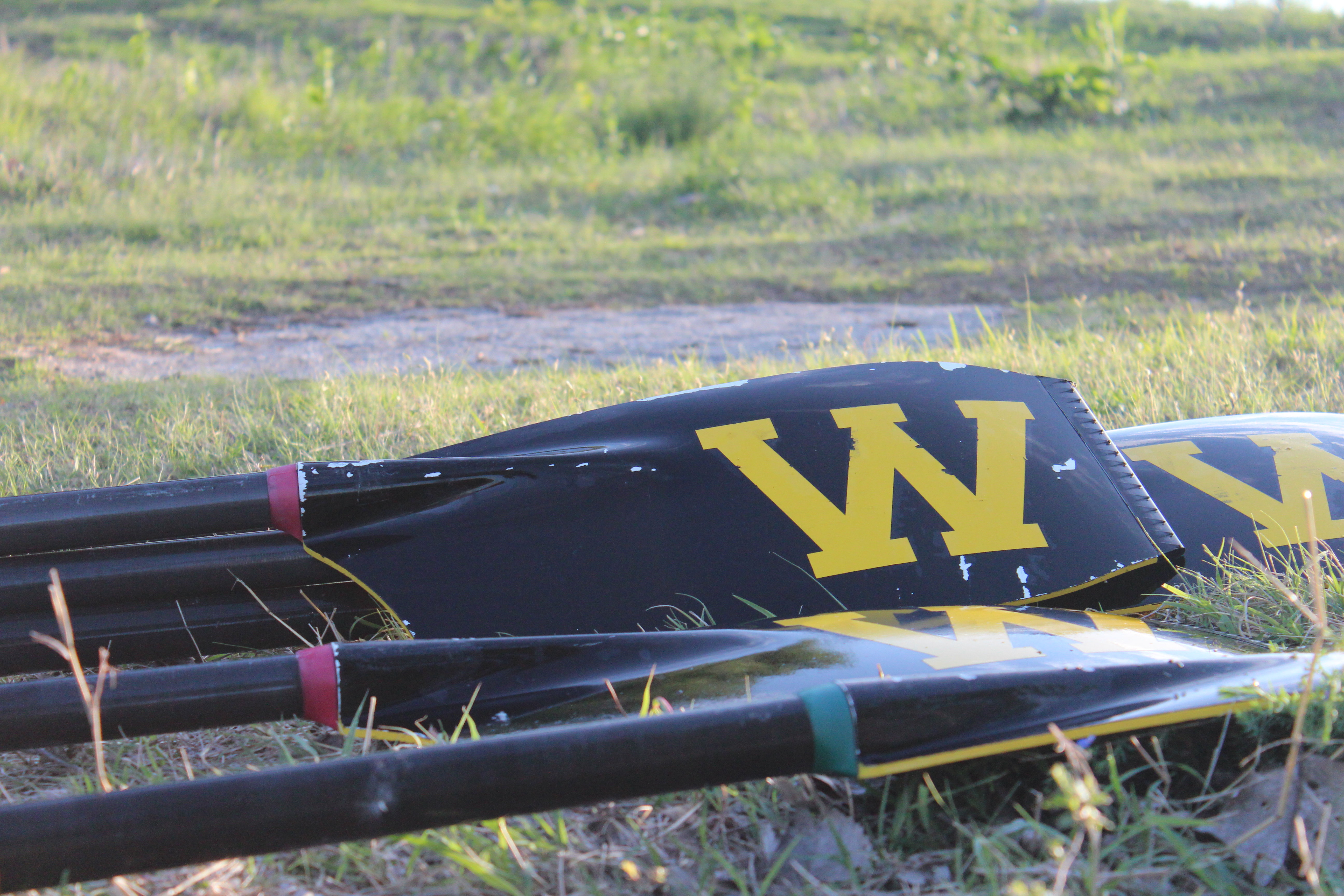Rowing Terminology
ABEAM: Directly off the side of the shell.
BACK IT DOWN: Command from the coxswain for rowers to reverse blades and row backward in short strokes.
BLADE: Flat surface of oar usually varying in width from 6 1/2 inches to 7 1/4 inches and in length from 24 to 30 inches. The surfaces of the blades are usually painted in the team's colors.
BLADE WORK: Action of blade during stroke, encompassing such techniques as "catch," "feathering, etc., used to describe the manner in which the rower handles the oar.
BODY ANGLE: Amount at catch of forward lean of oarsperson's body from hips. Most stroke types have a 60 degree body angle to catch.
BOW: The forward section of the shell. Crosses the finish line first.
BREAKAGE: The damage to a boat or to equipment. Breakage during the first 20 seconds of a race is grounds for a referee to recall all shells and restart the race.
CATCH: That point in each stroke cycle at which the blade enters the water.
CATCHING A CRAB: to lose control of oar, usually as it jams in water as boat moves on causing the oar to drive down into the water.
CHECK: Amount of interruption of forward progress of the shell. Commonly occurs at the catch and sometimes at the release.
COLLAR: Portion of the oar shaft which fits into the oar lock for leverage by the rower.
COUNT DOWN WHEN READY: command to crew to signal when ready to row by calling out their seat number in order, starting from rower furthest away from the coxswain.
COXED FOUR (4+): Boat rowed by four persons, each having one oar and that is steered by a coxswain.
COXSWAIN (cox-n): Member of the crew who sits in a stationary seat at the stern or lies in the bow facing forward. Primarily charged with stearing. Often calls rate and aids in carrying strategy by gauging the competition's position. Steers the boat and is the on-the-water coach. Must weigh at least 100 pounds.
DECK: Sections for shell at bow and stern covered by thin light material.
DOUBLE: boat rowed by two persons, each having two oars.
DRIVE: Part of rowing stroke between catch and release, blade in submerged in the water and rower is applying pressure to foot structure.
FEATHERING: At the end of the drive, blade turns from vertical to horizontal so that the oar is parallel to the water.
FINISH: As part of the stroke cycle, the last part of the drive before release.
FOOT STRETCHER: "Shoes" against which the rower pushes on for leg drive. Adjustable for leg length.
GUNWALES (gun-nels): Upper edge of sides of boat.
LAYBACK: Amount of lean of rowers body at finish. Less angle then the catch.
LEG DRIVE: Power applied to stroke by legs against the stretcher towards bow.
LET IT RUN: Command to stop rowing while boat continues to glide.
LIGHTWEIGHT: Crew in which oarsmen weigh under 165lb in the Fall and under 160 in the spring. Crew in which oarswomen weigh under 135lb in the Fall and under 130 in the spring.
LOOM: Shaft of oar, between blade and handle.
PAIR: boat rowed by two persons, each having only one oar.
PORT: Left side of boat when facing bow.
PUDDLES: Swirls left in the water by blade as rower pulls. Their size indicates how hard and how well a rower is pulling.
QUAD: boat rowed by four persons, each having two oars.
RACING START: First few strokes of race. Usually shorter and quicker than those used through the body of the race. Critical in setting tempo.
RECOVERY: Part of rowing stroke, when blades are out of the water, when rower pushes oar handle away and slides seat up towards the catch.
RIGGER: Projecting support structure that attaches oar shaft to the boat
Set it up/Set the boat: Command to get the boat on even keel if leaning to one side.
SCULLING: Type of rowing in which each rower has two oars
SHOOTING THE SLIDE: when on the pull, hips go back on slide before the shoulders (incorrect sequencing)
SQUARING: Prior to reaching the catch, the blade turns from horizontal to vertical so that the oar is perpendicular to the water.
STARBOARD: Right side of boat when facing bow.
STERN: The rear of the shell.
STRAIGHT FOUR (4-): Boat rowed by four persons, each having one oar and without a coxswain.
STROKE RATE: Number of strokes per minute. Usually varies in a race from 38-40 at start to 28-34 in the middle and 34-42 at the finish.
SWEEP: Oar, usually 12 feet long, one per rower, less than 7 lbs in weight. See "loom" and "blade" for more information.
WAY ENOUGH: Command to stop rowing


